Contents
When buying tomato seeds, each person studies the characteristics of the variety on the package. Usually, it contains information about the time of sowing grains and ripening of fruits, a description of the size and color of the tomato itself, and also describes a brief agricultural technology of the crop. In addition, the manufacturer must indicate what kind of plant it is: undersized or tall. But if the height of a tomato is indicated by such a simple name, everything is clear to anyone with this. But when the inscription indeterminate tomatoes is found, such a designation of uninitiated gardeners is misleading.
What are indeterminate varieties
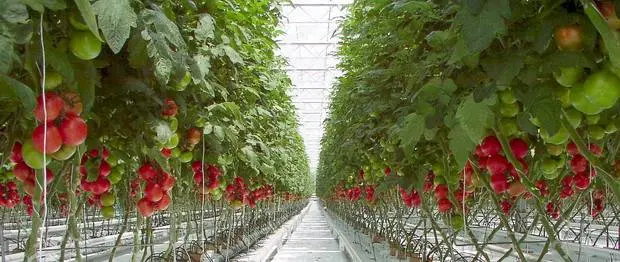
The answer to this question is quite simple. Indeterminate varieties are the same tall crops. Such tomatoes are characterized by unlimited stem growth and, moreover, it does not matter whether it is a variety or a hybrid.
In hot countries or heated greenhouses, the growing season of the indeterminate tomato lasts more than a year. During this period, one bush is able to bring up to 50 brushes with tomatoes. All tall tomatoes require the formation of a bush. This process involves removing extra stepchildren to make one or two stems. We’ll talk more about this later.
Having decided to acquire indeterminate tomatoes, you must first consider the possibilities of growing them. In the southern regions, such a tomato can be planted in open and closed ground. As they grow, the stems are tied to a trellis or wooden stakes driven into the ground. For the middle band, the cultivation of indeterminate varieties in greenhouse conditions is recommended. But residents of the northern regions are better off refusing such tomatoes. The peculiarity of these varieties lies in the late ripening of the crop in relation to other tomatoes. For a short warm summer, the fruits simply do not ripen.
And finally, it must be said about the flowering of indeterminate tomatoes. The first flower is laid after 9 or 12 leaves, and all subsequent ones every 3 leaves. This, in principle, is a short answer to the question of indeterminate tomato varieties, what is it, well, then we will try to analyze in more detail all the features of such tomatoes.
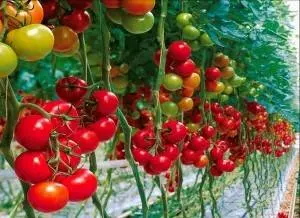
Benefits of growing
The main advantage of indeterminate varieties is space savings. On a small bed, you can plant a dozen plants and, due to the ovary of a large number of brushes, get several times more tomato crop than, for example, from 20 undersized bushes. The normal indicator is 13-16 kg of tomatoes from 1 m2 beds
Another advantage is the availability of creating the best growing conditions for tomato.
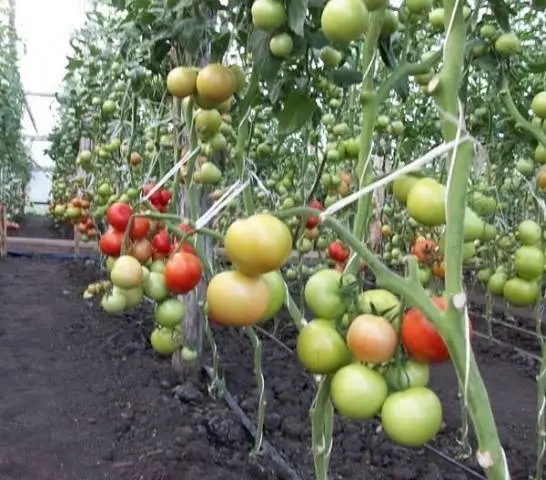
Of course, here you have to work hard with the garter of the stems. To do this, you will need to build trellises or drive stakes near each bush, but at a height the plant will feel better.
The leaves will receive uniform coverage of the sun’s rays, free access of air will be provided. All this will reduce the risk of damage to the bushes by late blight and fungal diseases.
We also need to touch on the growing season. Indeterminate varieties bear fruit longer. Low-growing tomatoes most often give the entire crop at once. For sale or processing, this is, of course, convenient, but making fresh tomato salads at home throughout the summer will not work. Indeterminate tomatoes most often ripen unfriendly. A new ovary will constantly appear on the bushes until the onset of the first frost, which means that fresh tomatoes will be on the table for the whole summer until late autumn.
And, finally, tall bushes are easier to form even for an inexperienced gardener. All stepchildren are simply removed from the plant, leaving only the stem.
Sowing seeds and growing seedlings
There are no special differences in growing seedlings of indeterminate tomatoes from undersized varieties, but let’s take a look at how this is done at home:
- To grow seedlings of indeterminate tomatoes, a longer period of about 50 to 65 days is required. This must be taken into account and the seeds sown a little earlier, somewhere from March 15th. For sowing seeds, boxes with a moist substrate are used. The grains are laid out evenly in rows. Such a scheme will provide optimal lighting for germinated sprouts. The spread out seeds are covered with a 5 mm layer of peat or sand on top.
- A box with sown tomato seeds is tightly covered with a transparent PET film and placed in a warm place with a constant air temperature of +23оC. The first sprouts should emerge in 5 or 6 days. Now it’s time to remove the film from the box, but it’s better to do it in the morning or in the late afternoon. The choice of this time is due to less evaporation of moisture at noon.
- When opened, seedlings will germinate for at least 6 more days. When at least one true leaf grows on the sprouts, they start picking in separate cups.
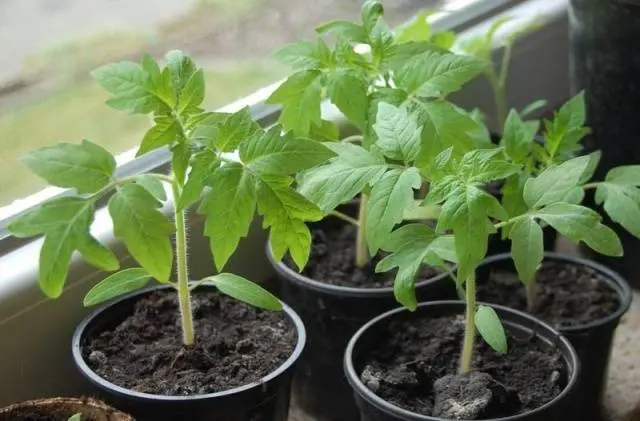
After picking, cups with seedlings are placed in empty boxes for further cultivation.
Influence of temperature conditions
Every vegetable grower wants to get stocky tomato seedlings at home and always with short internodes. The whole secret is to maintain a round-the-clock temperature in the range of 23-24оC. After about 25 days, the temperature is reduced by a maximum of 2 degrees. Maintaining this temperature promotes the formation of the first 3 brushes.
14 days before planting in the ground, the temperature in the room where the seedlings grow is reduced to +19 during the dayоC, and at night you can withstand +17оC. It is important here not to overdo it with a decrease in temperature, otherwise it will negatively affect indeterminate tomatoes. The fact is that the development of the plant is inhibited in the cold, and the laying of the first brush will turn out not where it is necessary, that is, very low. And as we said above, the first flower in indeterminate tomatoes should be laid at least 9 leaves. Of course, low flower formation will not be detrimental to the plant, but this will lead to a poor tomato crop in the future.
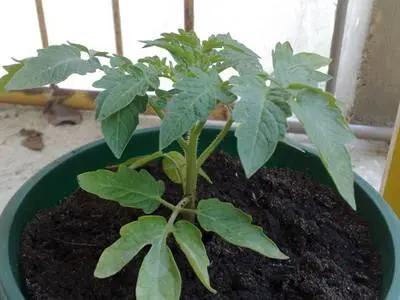
If the garden is far from home, the seedlings will have to be transported or carried by hand. It should be noted that immature plants react painfully to temperature changes and drafts. It is optimal to hide seedlings under PET film until they are delivered to the landing site. Before transportation, it is important to refuse watering. Plants that have gained moisture become very fragile. By the way, it is impossible to transfer tomato seedlings lying down.
Now let’s see how healthy indeterminate seedlings should look like before planting in the ground:
- A flower brush should form above the 9th or 10th leaf. It is necessarily tilted down, has a short leg and the correct shape.
- The optimal length of the internode is from 5 to 7 cm. All of them must be correctly positioned according to the characteristics of a particular variety.
A powerful stem will tell about strong indeterminate seedlings. It should not be thin, but too thick a stem is also bad.
Transplanting
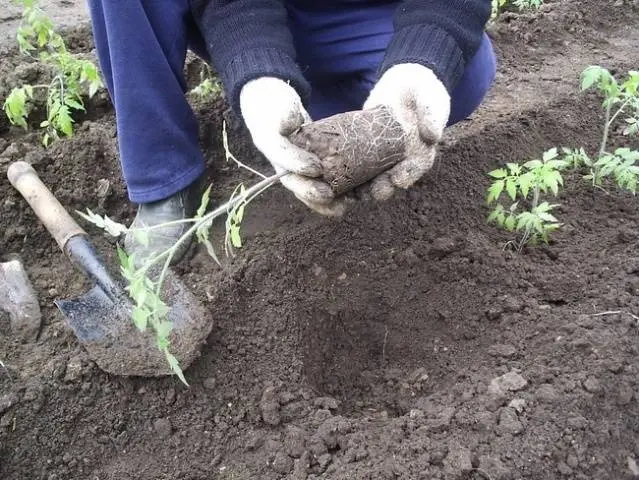
Each plant is carefully removed from the cup along with a lump of soil. Holes are dug in the garden with such a condition that after planting, the native clod of earth from the cup rises about 2 cm above the soil of the garden.
After planting, the plant must be watered with warm water, but this must be done under the root. Water that gets on young leaves will leave traces of burns.
When planting seedlings of indeterminate tomatoes, adhere to a density of no more than 5 plants / 2 m2. Usually, gardeners plant bushes in rows with a step of 0,5 m. The aisles are left at least 0,7 m in size. For the convenience of tying the lashes to the trellis, the bushes are staggered.
Ways to form an indeterminate bush
The formation of a tall tomato is not particularly difficult and involves the simple removal of side shoots. It is customary to form bushes in one or two stems. Let’s look at all the advantages and disadvantages of each method.
Formation of a bush with one stem
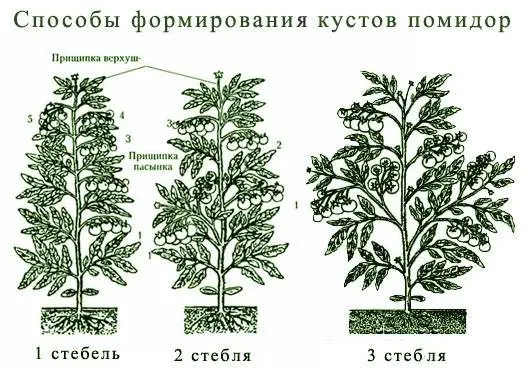
An indeterminate plant is a kind of vine that grows almost indefinitely. The easiest way is to form a bush with one stem. To do this, do not pinch the top of the plant, and remove all emerging side shoots. For gardeners, this procedure is called pinching. Usually, indeterminate plants are formed into one stem in greenhouse industrial cultivation.
The advantage of this method is the easy formation of a bush, dense planting and more yield from 1 m2. The disadvantages include the impossibility of such a formation in home greenhouses, since usually their height does not exceed 2,5 m.
There is another way to form with one stem. It is based on leaving one shoot under the first flower. The growing stepson is tied to the trellis until 1 or 2 brushes appear on it, and then its top is pinched.
The advantage of this method is to get more yield from the bush. In addition, the extra ovary slows down the growth of the main stem, which is convenient for low home greenhouses. The only downside is the extra time spent on the garter and pinching the stepson.
Formation of a bush with two stems
The best way to form an indeterminate bush at home is considered to be two stems. To do this, one shoot is left under the first flower, which will constantly grow in parallel with the stem. All emerging new stepchildren are removed.
The advantage of such a formation lies in the same obtaining a larger yield and limiting the growth rate of the entire plant. The disadvantages include an increase in the step of planting seedlings. With the formation of more ovaries, the plant requires additional fertilizing with fertilizers.
The video shows the care of tall varieties:
Garter Rules
The optimal structure for tying indeterminate tomatoes is a trellis. It is made of metal racks at least 2 m high, between which a rope or wire is stretched. The stem of the tomato begins to be tied under the third leaf.
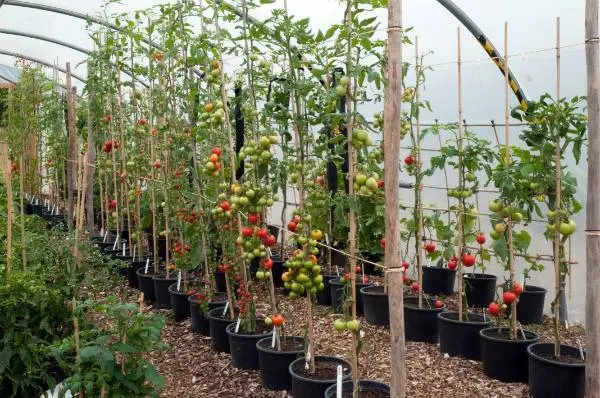
It is convenient to use coils in the design of the trellis, with which the ropes are fixed. This allows the thread to move along the trellis. When the bush stretches to the upper jumper, using the same coil, the top of the stem is shifted to the side. Further, the growing stem is directed to the grid or other supports, and the lower leaves are removed.
In the absence of coils, the grown stem is thrown over the upper bridge of the trellis, and at an angle of 45о lower it down with a gradual garter. In this case, the bush should form at least 9 brushes. When the tomato stalk drops to a maximum of 0,5 m to the ground, pinch its top.
How to distinguish indeterminate varieties from determinant ones
It must be said right away that all low-growing varieties are called determinant tomatoes. But we will not consider them, but we will learn how to determine the difference between these two species from the earliest period of life.
Seedling difference
On the third or fourth day after the appearance of sprouts, the cotyledon knee straightens. In low-growing tomatoes, its maximum length is 3 cm, and in indeterminate varieties – 5 cm. But with improper shaded seedling cultivation, it is extended, and determination in this way becomes impossible.
Seedling difference
Adult seedlings of determinant tomatoes form a flower brush over 6 leaves. Seedlings of indeterminate varieties throw out the first flower over the 9th leaf.
Difference by rooted plant
When a bush has taken root and already has several brushes, it is difficult to determine whether it belongs to one of the groups.
An adult indeterminate plant does not have a shoot, at the end of which there is an ovary, which is inherent in low-growing varieties. Although you can make a mistake here if, when forming a tall bush, the stepson pinched right behind the brush. Therefore, it is better to determine by the number of sheets.
Tall varieties of tomatoes belonging to the determinant group have been bred. Less than three leaves grow between their brushes. There are even indeterminate varieties related to standard crops. A vivid example of this is the late tomato “Volgogradsky 5/95”.
For a note, it must be said that the height of a stem plant is much less than that of a determinate plant. Its stem is so powerful that it can withstand any number of fruits without a garter. By the way, standard tomatoes do not stepchild.
The video shows indeterminate and determinant varieties:
Conclusion
We hope that novice vegetable growers have figured out the basic definitions of indeterminate tomato varieties, and now there will be no unnecessary questions when studying the characteristics on the package.









